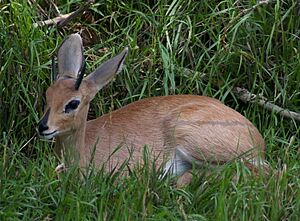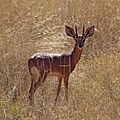Steenbok facts for kids
Quick facts for kids Steenbok |
|
|---|---|
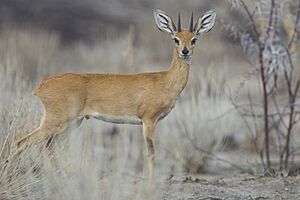 |
|
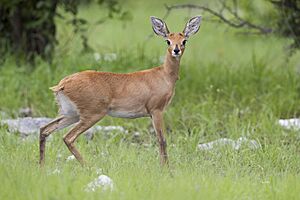 |
|
| Male and female in Etosha N. P. | |
| Conservation status | |
| Scientific classification | |
| Genus: |
Raphicerus
|
| Species: |
campestris
|
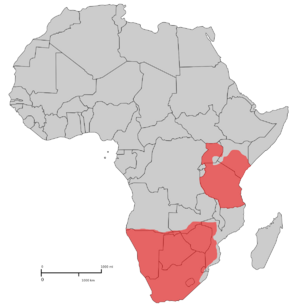 |
|
|
Distribution based on 1970s data.
|
|
The steenbok (pronounced STAYN-bok or STEEN-bok) is a small, common antelope. You can find these animals in parts of southern and eastern Africa. People sometimes call them the steinbuck or steinbok.
Contents
What Does a Steenbok Look Like?
Steenboks are small, standing about 45–60 cm (16–24 inches) tall at the shoulder. They weigh between 7 and 16 kg (15–35 pounds). Their fur can be light brown to a reddish-orange color. Their belly, chin, and throat are white, and they have a white ring around their eyes.
Special Features
Steenboks have large ears with special "finger-marks" inside. Males have straight, smooth horns that are 7–19 cm (3–7.5 inches) long. They have a black crescent shape between their ears and a shiny black nose. A small black scent gland is found in front of each eye. Their tail is very short, only 4–6 cm (1.5–2.5 inches) long, so you usually can't see it.
Where Do Steenboks Live?
Steenboks live in two main areas of Africa. In East Africa, you can find them in central and southern Kenya and northern Tanzania. They used to live in Uganda, but they are likely gone from there now.
In Southern Africa, steenboks live in Angola, Namibia, South Africa, Eswatini, Botswana, Mozambique, Zambia, and Zimbabwe. They might also be in Lesotho.
What Kind of Places Do They Like?
Steenboks live in many different types of places. These include semi-desert areas, like the edge of the Kalahari Desert and Etosha National Park. They also live in open woodlands and thick bushes. This includes open plains, rocky savannah, and areas with Acacia trees and grass. They seem to like places that are changing or in between different habitats.
In places like Kruger National Park in South Africa, steenboks prefer Acacia tortilis savannah all year. They don't move to wetter areas during the dry season, unlike many other large animals.
What Do Steenboks Eat?
Steenboks mostly eat plants that grow low to the ground. They can't reach food higher than about 0.9 meters (3 feet). They are also good at digging up roots and tubers. In Kruger National Park, they especially like forbs (small flowering plants). If there aren't many forbs, they will eat woody plants like Flueggea virosa.
They also eat fruits and rarely eat grass. Steenboks get almost all the water they need from their food. This means they don't usually need to drink water.
How Do Steenboks Behave?
Steenboks are active both during the day and at night. When it's very hot, they rest in the shade during the day. They spend more time eating at night during the dry season. When they rest, they might groom themselves, chew their cud (like cows do), or take short naps.
How Do Steenboks Stay Safe?
When a steenbok senses danger, it usually lies down low in the plants to hide. If a predator gets too close, the steenbok will jump up and run away in a zigzag pattern. This makes it harder for the predator to catch them. As they run, they often stop to look back. They might even hide in burrows dug by aardvarks.
Animals that hunt steenboks include the Southern African wildcat, caracal, jackals, leopard, martial eagle, and pythons.
Steenbok Life Cycle and Reproduction
Steenboks usually live alone, except when a male and female come together to mate. It's thought that pairs might have their own areas but live separately. They stay in touch by leaving scent markings, so they know where their mate is. They often use piles of dung to mark their territory. These territories can be from 4 hectares (about 10 acres) to 1 square kilometer (about 0.4 square miles) in size.
When a female is ready to mate, the male becomes more aggressive. He might try to scare away other males with displays.
Baby Steenboks
Steenboks can have babies all year round. However, more fawns (baby steenboks) are born from November to December, which is spring and summer in the southern parts of Africa. Some females can even have babies twice a year.
The mother carries the baby for about 170 days. Usually, only one fawn is born. The fawn is born quite developed and can move around soon after birth. The mother hides the fawn in plants for about two weeks. The fawn drinks its mother's milk for three months. Female steenboks can have their own babies when they are 6–8 months old, and males can mate at 9 months.
Steenboks can live for 7 years or even longer.
Images for kids
-
Female running in Damaraland, Namibia



